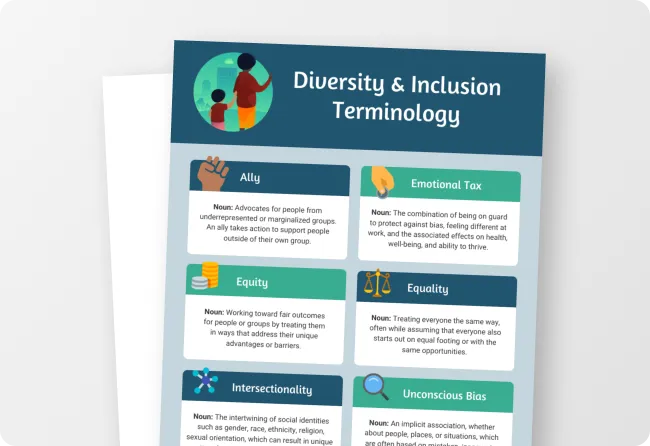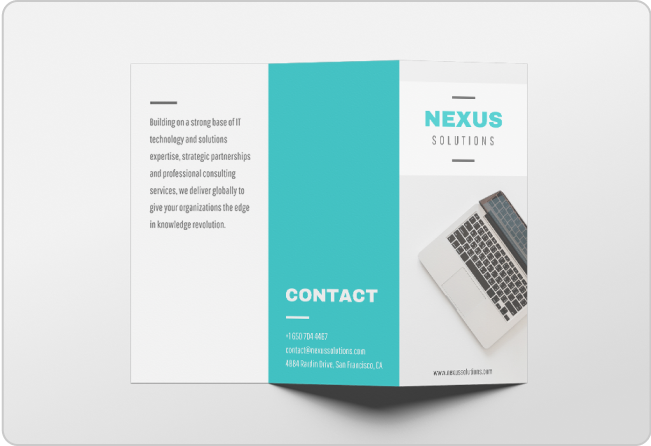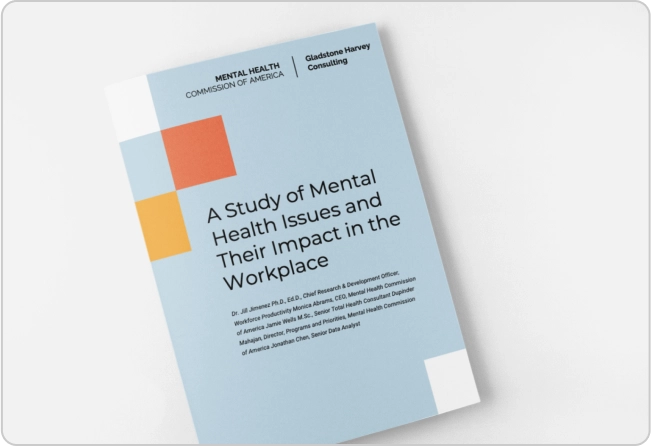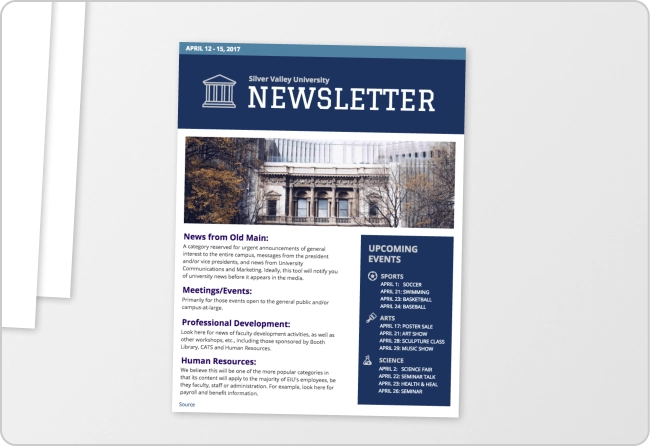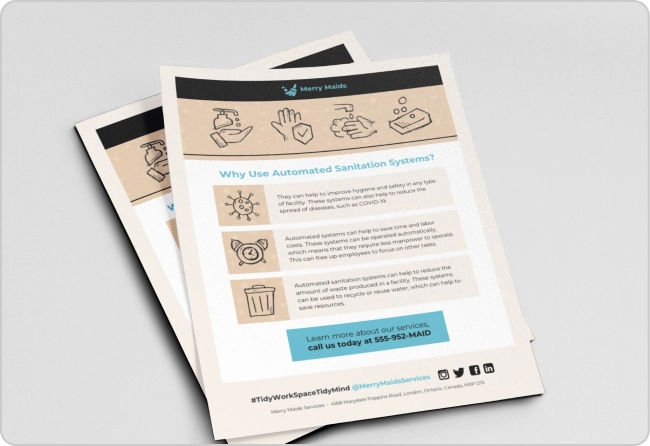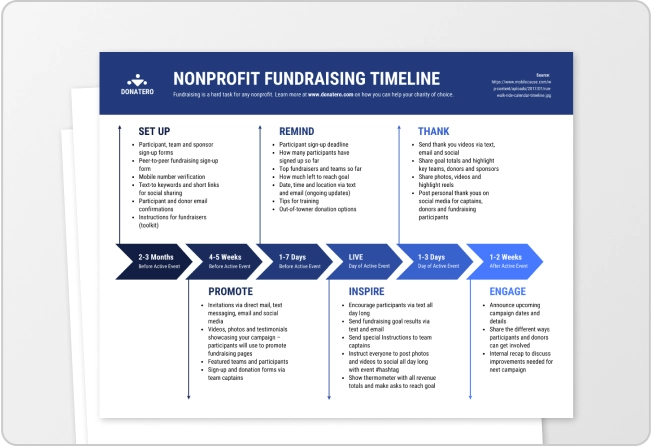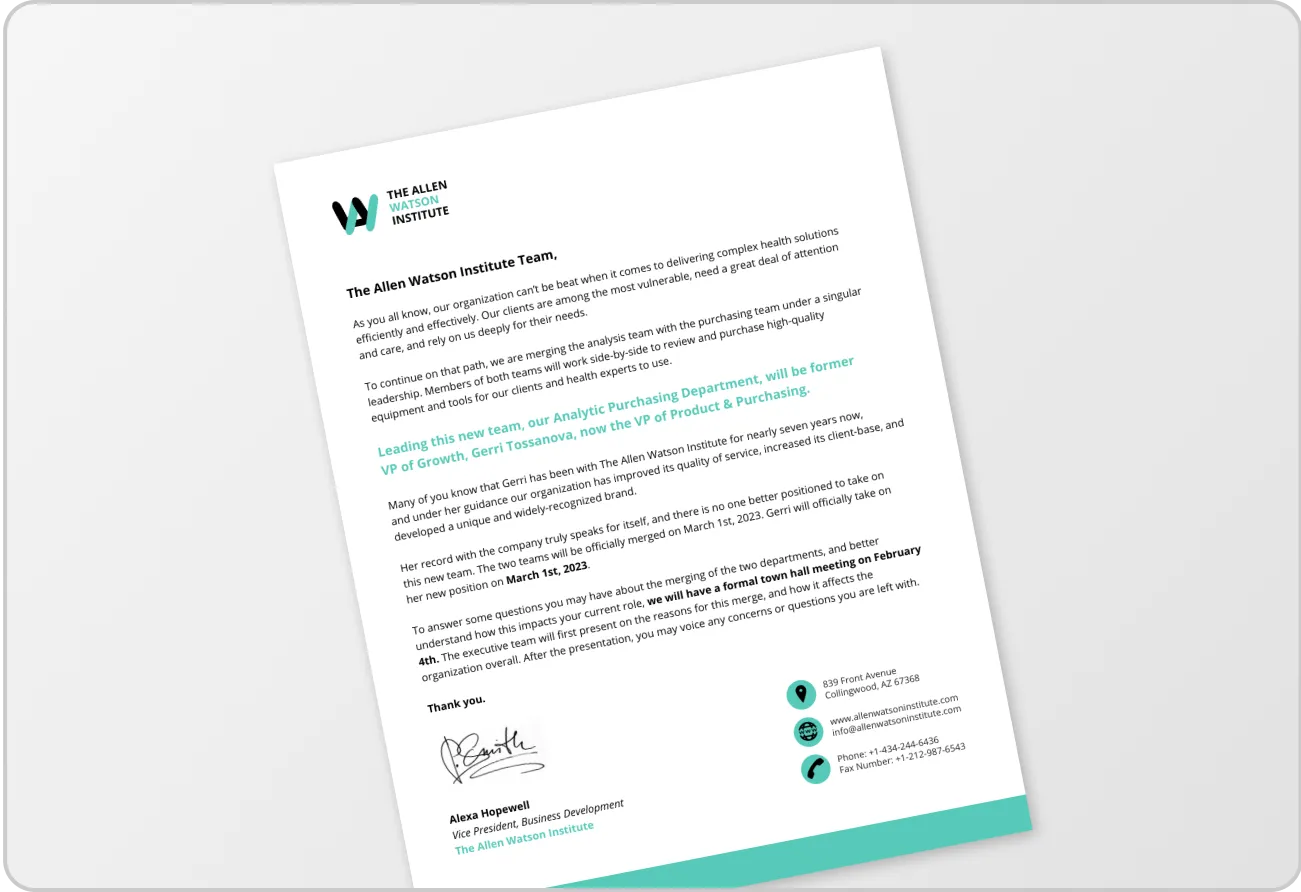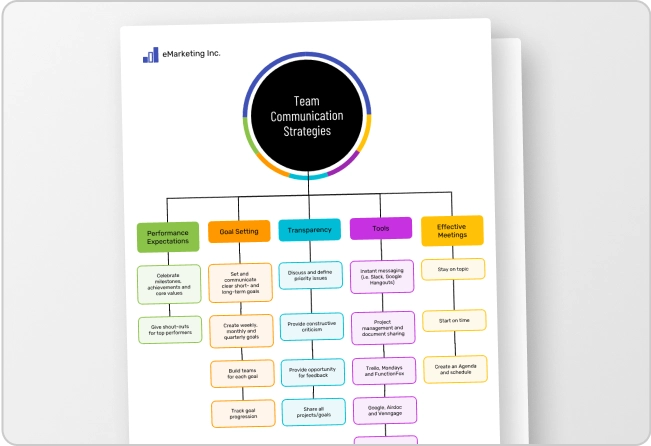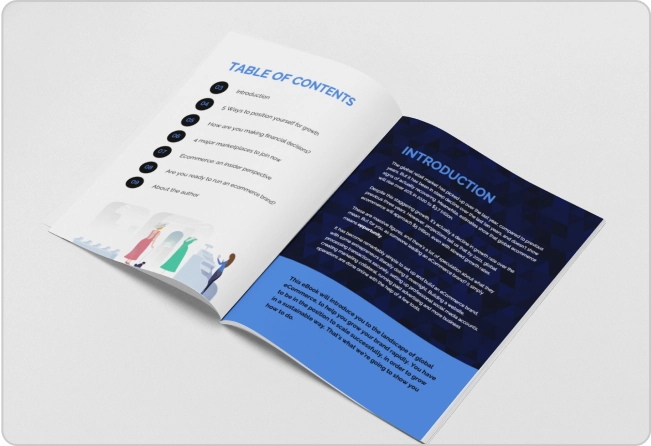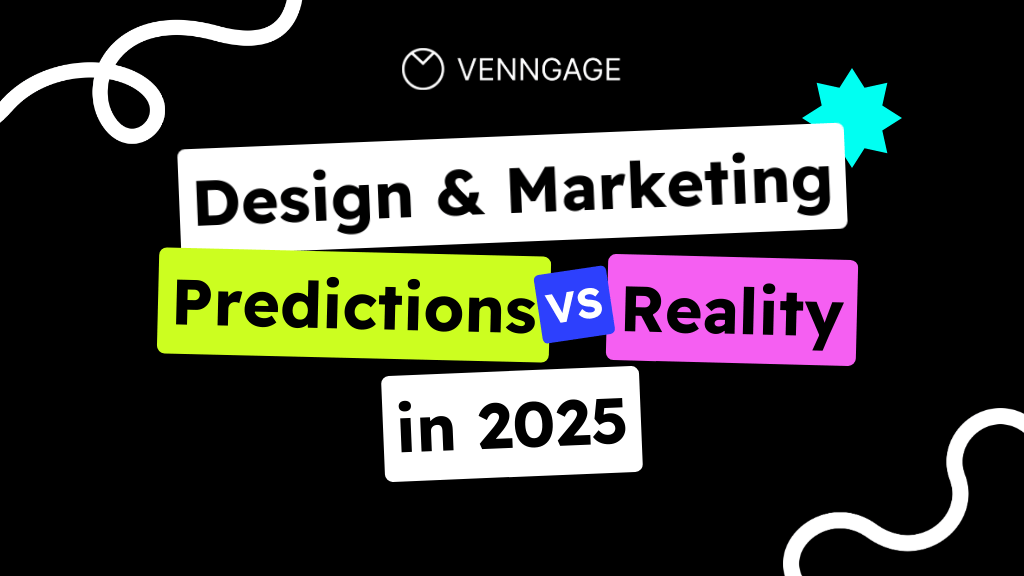
Everyone loves trend posts… But who checks back later? At Venngage, we decided to hold ourselves accountable.
This post revisits three blogs from the last year that we published, predicting a variety of trends across digital marketing, content, and design. This is a follow-up blog to check what actually played out: what worked, what didn’t and what we misread entirely.
This is Part 1 of a two-part series. Part 2 will look ahead to 2026, so you can plan for what’s next with fewer blind spots.
Section 1: Infographic design trends: What stuck, shifted or slipped away?
Back in late 2024, we mapped out a few trends we believed would shape 2025.
If you missed it or want a full recap, read our predictions for infographic design trends for 2025.
What we predicted
- Interactive storytelling: We said infographics will move beyond static visuals by adding clickable elements, hover effects, dynamic charts, or embedded video to engage users directly.
- SEO‑friendly designs: We expected creators to optimize infographics for search by using descriptive filenames, alt text, metadata and structures tailored for Google Images and featured snippets.
- Micro‑infographics for social media: We predicted a rise in bite‑sized, single-statistic graphics designed for LinkedIn, Instagram, TikTok and other platforms to match vertical consumption habits and grab attention fast.
- Subject‑matter expert visualizations: We saw niche industries like healthcare, fintech or engineering adopting domain-specific infographics to explain complex topics with precise visuals and annotations.
What our survey data shows
Our survey data revealed that many of the infographic design trends we predicted in late 2024 did, in fact, gain traction with marketing teams in 2025. But not all in equal measure.
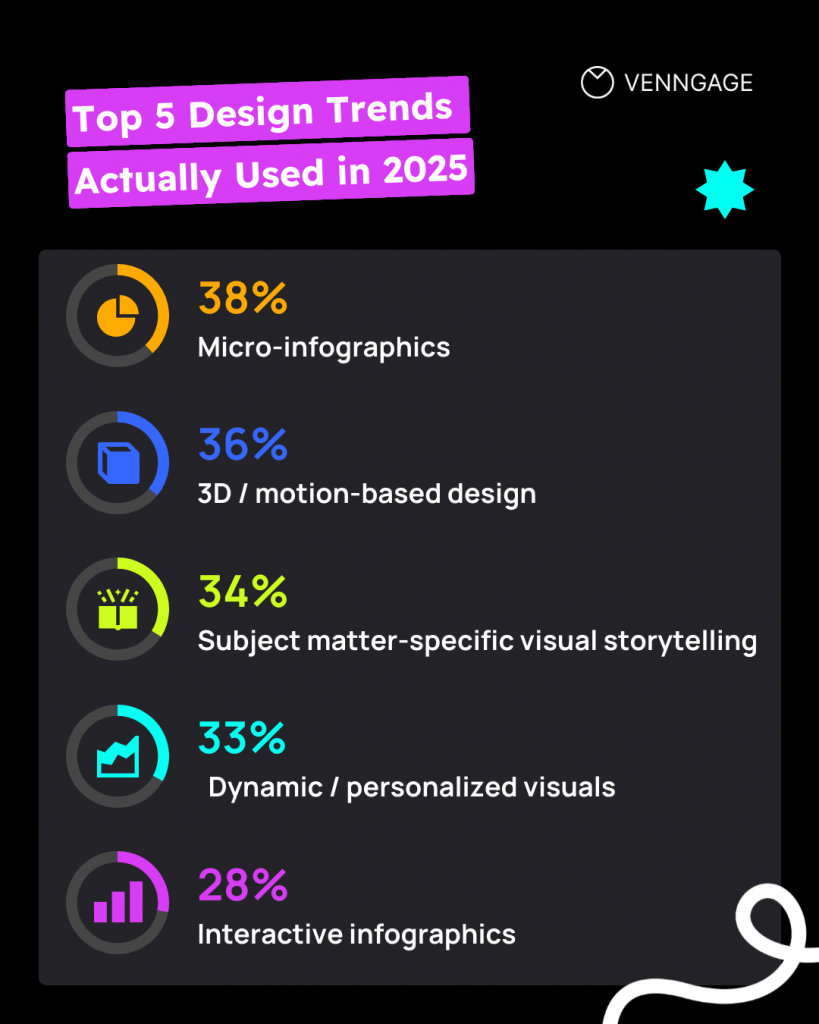
- Interactive infographics
- Adoption was slower but noticeable, with 28% saying they used them. Among adopters, 53% reported they generated “strong interactions such as comments, likes, and shares.”
- SEO-optimized visuals
- Adoption trailed slightly at 26%. Still, 50% of those who leaned into this tactic attributed it to strong performance in reach, impressions, and clicks.
- Micro-infographics for social media
- This emerged as the strongest adoption trend. 38% of respondents reported using them in their campaigns, with 37% calling them effective in driving strong performance (reach, impressions, clicks).
- Subject-matter-specific infographics
- About 34% reported positive audience feedback such as praise, compliments, or constructive input. In total, 34% said they used (or plan to use) subject matter-specific storytelling in 2025 campaigns — and these often outperformed expectations.
What this means
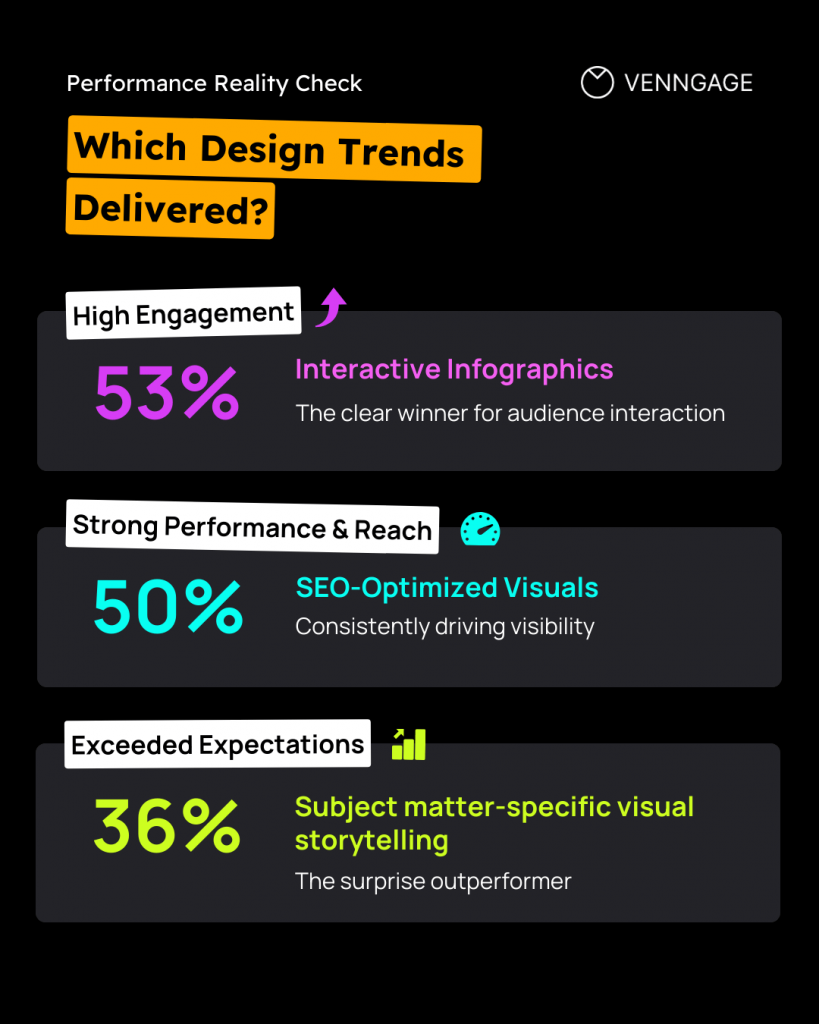
- The more lightweight and snackable a format, the faster and better its adoption. Interactive and technical storytelling proved their worth among teams that invested the effort.
- For attention-driven platforms like TikTok, LinkedIn, and Instagram, the appeal of “bite-sized visuals” clearly has a growing impact.
- Social-first designs work best when designed for distribution, not just aesthetics.
- While interactive infographics are a bit resource-heavy to produce, they pay off in user activity when executed well.
- While half of adopters attribute them with strong reach, SEO-optimized visuals are still pretty underused. In my view, SEO visuals come with “long-tail” value and offer compounding benefits.
In 2026, the most successful brands won’t be the ones with the loudest voices, but the ones
with the clearest values. As AI levels the playing field for content creation, trust, transparency,
and purpose will become the ultimate competitive advantage.
Anonymous marketer
Verdict:
Mostly accurate: Our predictions held up, with micro-infographics leading adoption and subject-matter storytelling gaining traction. However, interactive and SEO-driven designs have plenty of room to grow in 2026.
Section 2: AI in content and design workflows: Reality check
AI played a big role in creative workflows in 2025, like we had predicted in our AI trends in design and content round-up. But not in the ways we had expected.
What we predicted
AI would become core to ideation, design and optimizationWe forecasted that in 2025, brands would rely on AI across ideation, drafting visuals, and optimizing content performance in real time.
What the data says
While the survey data reports widespread adoption, it’s a bit nuanced how (and where) AI has actually impacted everyday marketing and design work:
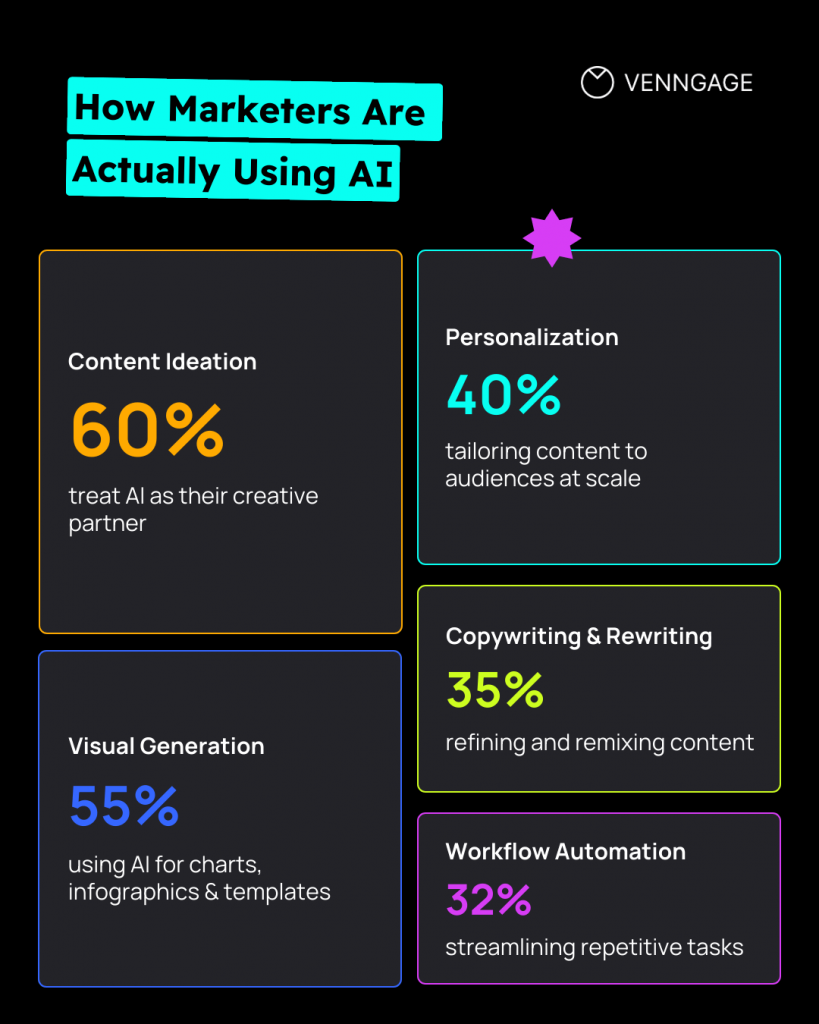
- AI tools are now the norm, not the edge cases:
- 58% of respondents said they are actively using AI in their marketing or content creation process.
- 17% are exploring but haven’t yet implemented it.
- About 26% reported not using AI at all.
- AI is touching every stage of creative work, but with varying emphasis:
- The most common use case is content ideation (60% of respondents), closely followed by generating visuals, such as charts, infographics, and templates (55%).
- Personalizing content (40%) and copywriting or rewriting (35%) are also prominent.
- This shows that teams are using AI increasingly for other dynamic customer-facing touchpoints.
- Notably, 29% are using AI for data storytelling or visualization.
- Does this mean today’s audiences are growing an appetite for richer analytics-driven content? We’ll check back in.
- AI-powered automation is on the rise too, with 32% using it for their current use cases.
- Impact is significant but not universal:
- Of those using AI, 65% said it has significantly changed how their teams work.
- But 32% say they’re still in an adaptation phase.
- Only 32% report no impact yet, a minuscule minority which we’re confident will come into the AI fold in the coming years.
- AI adoption isn’t free of friction: A lot of open-ended responses we received paint a picture of both speed and efficiency hurdles:
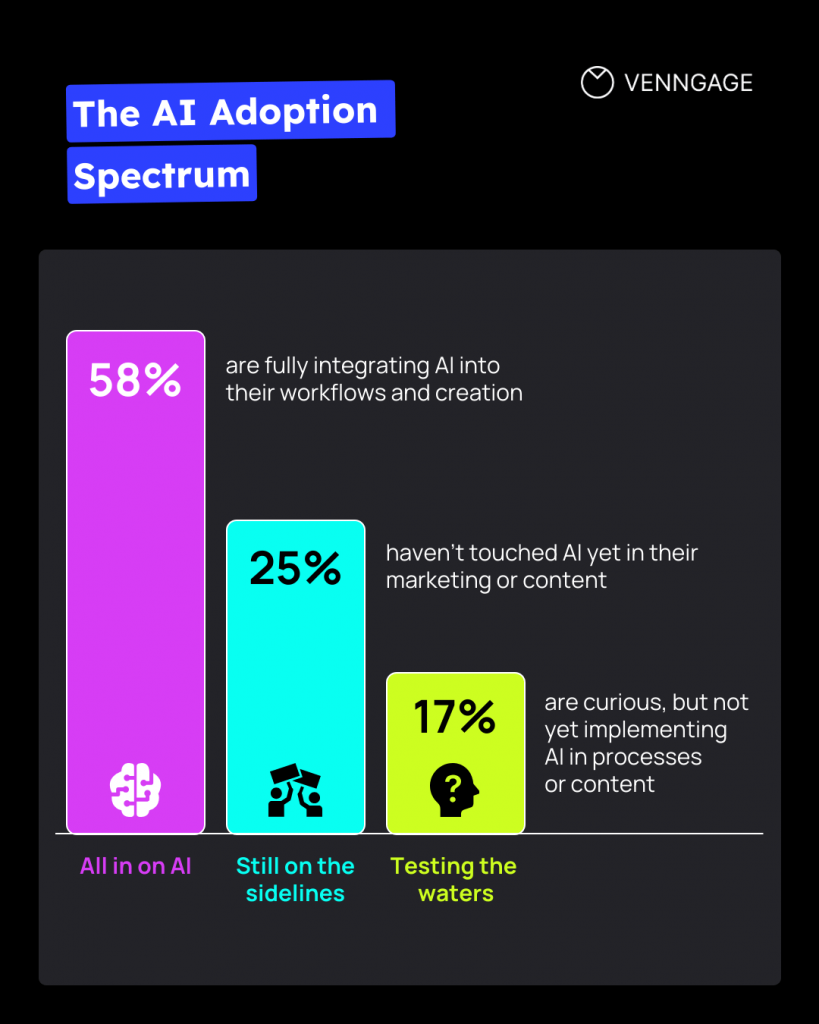
- Faster ideation and drafting are benefits repeatedly cited, as are broader creative possibilities.
- However, many flagged drawbacks like the need for frequent manual review of AI output (“you need to double-check for mistakes very often”), as well as the time required to refine or prompt AI-generated visuals (“it takes a lot more effort and time”).
- Some respondents mention the trade-off: while AI speeds up ideation, it often warrants heavy editing, frequent fact-checking and improvements to avoid generic or “fake-looking” outputs.
AI adoption looks different for different brand, and even across different use cases. Here’s how they fall across the spectrum from all-in to still waiting:
What this means
- In 2025, AI evolved from an experimental project to an everyday tool in content and design workflows. The majority of marketing teams report some form of improved productivity or creativity.
- However, the transition isn’t complete yet. Most teams are still involved manually to give AI outputs the creative polish and nuanced storytelling.
- Currently, AI’s strengths lie in ideation, speed, analysis and automating repetitive tasks. Teams still retain the human touch for quality control, authenticity and brand differentiation.
- That might be changing fast. A growing number of marketing teams see AI not just as a practical tool but as a “creative partner.”
- Teams that are making the most out of AI iterate, double-check and use AI as a catalyst.
We asked the survey participants:
What’s one surprising benefit (or drawback) you’ve noticed while using AI?
Here are some interesting takes:
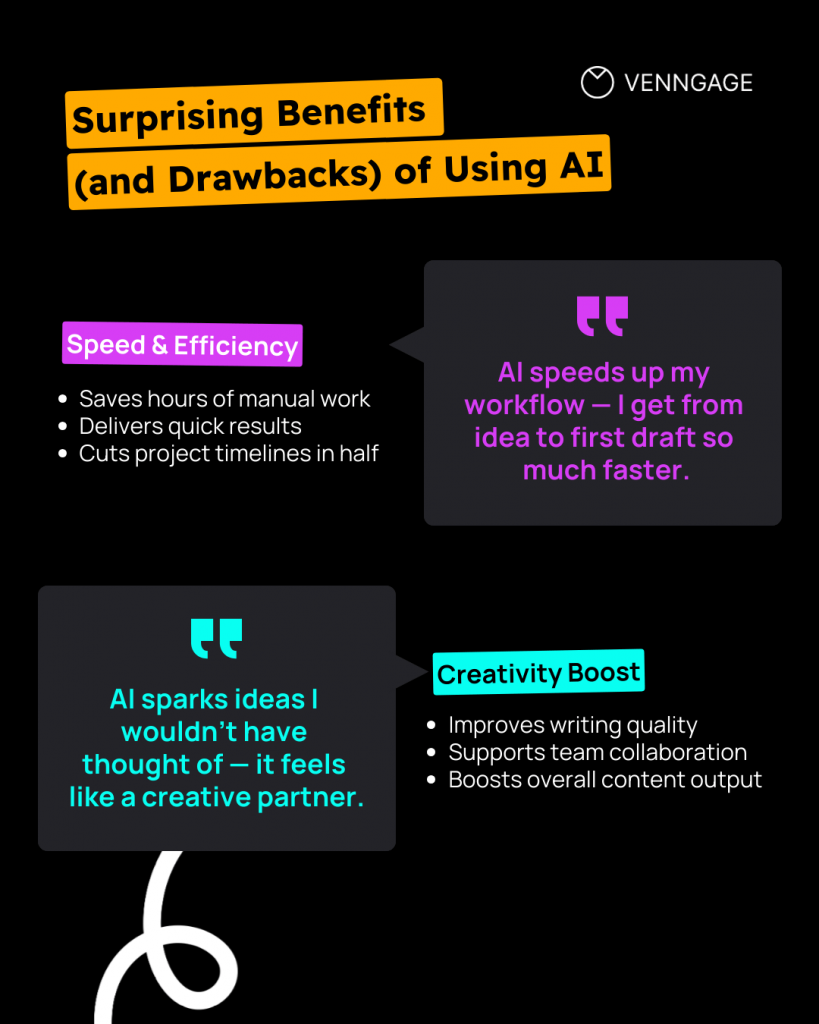
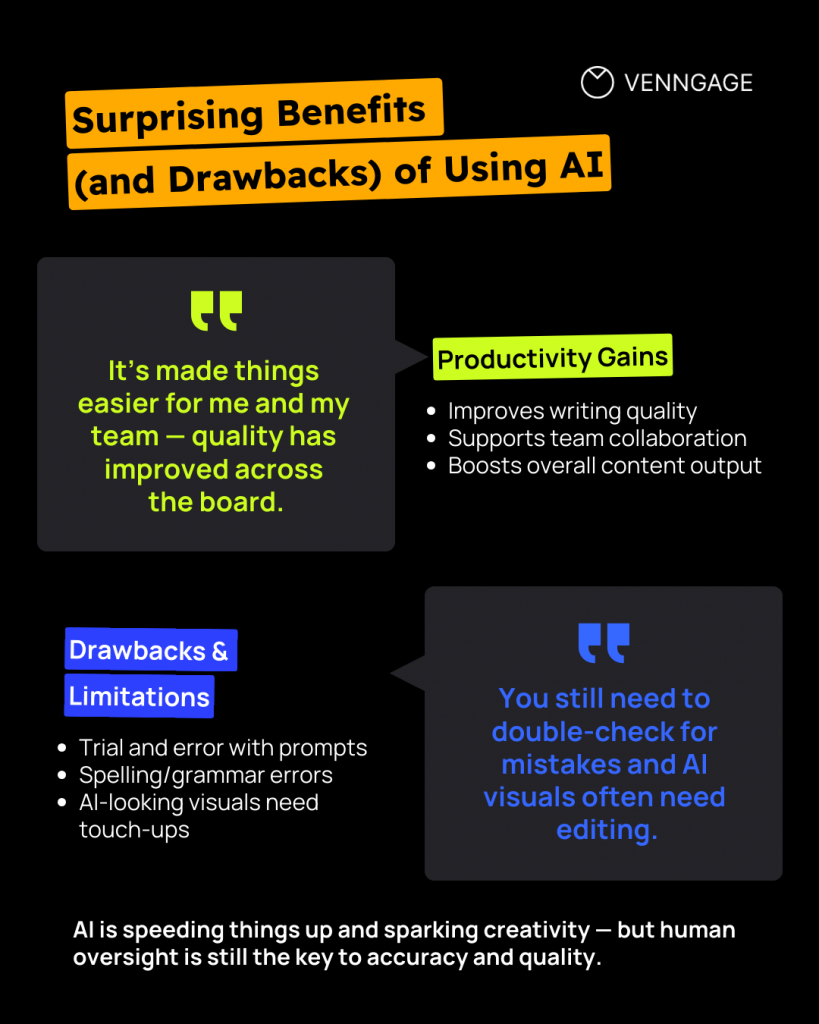
Verdict
Mostly Accurate: AI has found a strong footing in daily marketing workflows in 2025. However, its role as a true “creative partner” still relies heavily on human oversight.
As AI speeds up design and content creation, the one thing marketers can’t lose is the ability to turn raw data into emotional clarity. Machines can produce 500 ad variations in a minute, but they can’t replicate the weight of a single story. One rewritten offer email — sharing a trainer’s real success helping a 54-year-old walk 800 meters unaided — boosted conversions by 37%. That kind of human resonance can’t be simulated without a storyteller guiding the message.
Khris Steven – Founder of KhrisDigital Marketing
Expert insight
If I could recommend one change for brands preparing for the future it would be to speed up their content production process while keeping the quality high. The pace of cultural changes means a campaign that takes months to launch will miss the moment. Brands need agile systems with small cross-functional teams, connected creative and analytics workflows, and pre-approved style guides that allow fast changes.
Vaibhav Kakkar, Founder at DWS & RankWatch
Section 3: Digital marketing predictions: Overhyped or underrated?
In 2024, a lot of digital marketing predictions for 2025 sounded convincing (some even obvious). AI content creation, short-form video, visual SEO and AR shopping all made the list.
But a year later, the results tell a more nuanced story. Some trends delivered on the hype, while others fell flat or stalled in specific niches.
What we predicted
- We said that AI content creation would go mainstream and brands would publish AI‑generated blog posts, social captions and ad copy at scale.
- We expected short‑form vertical videos to dominate TikTok, Reels, and YT Shorts to become central to content strategy, with sub‑60‑second videos as the go-to format for engagement.
- We saw brands optimizing images and infographics for search engine optimization so that they show up in Google Images, answer boxes, and visual search results, creating new discovery paths.
- We predicted augmented reality (AR) tools and livestreaming shopping events would become mainstream, especially for eCommerce, fashion and beauty brands.
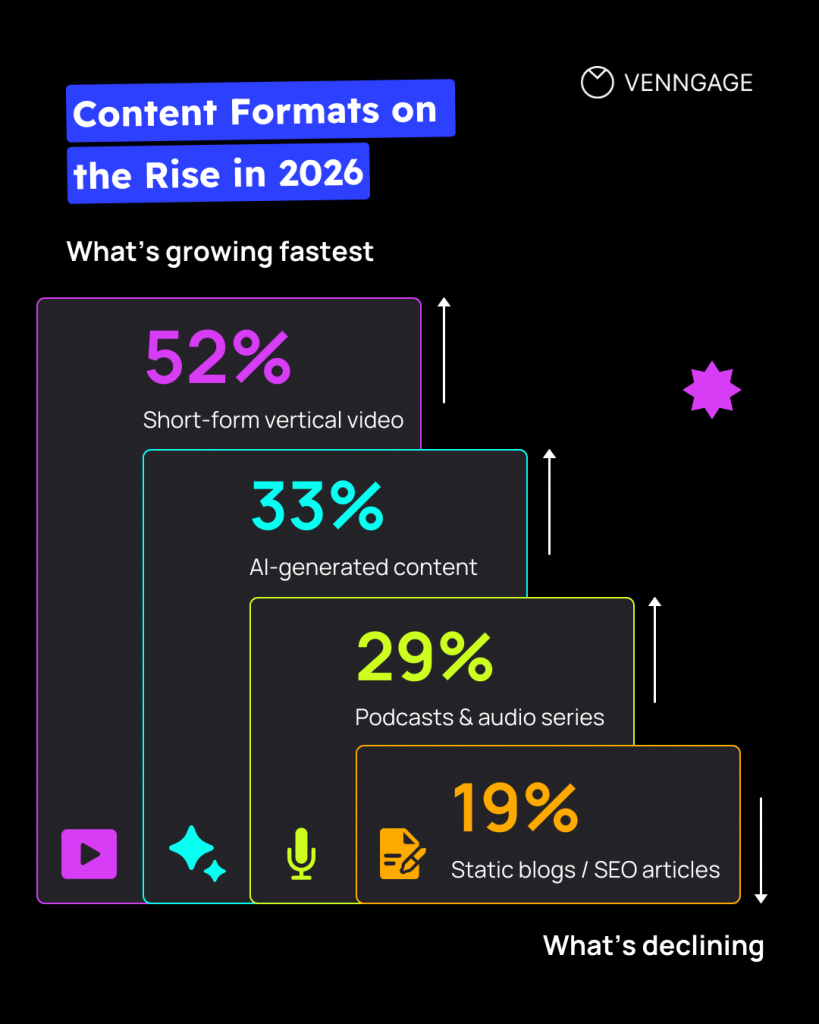
What the data says
When we look at how digital marketing predictions actually played out in 2025, the results show a mix of clear wins, steady risers, and trends that failed to break through.
Here’s how each major format performed:
- AI-generated content
- About 48% reported that AI-generated content exceeded expectations in their 2025 marketing. Only 10% felt this trend was overhyped or ineffective.
- Short-form video
- Adoption rates for short-form videos were high and impact was substantial. 49% of the people we surveyed reported that short videos exceeded expectations for their teams.
- It’s, by far, the most celebrated digital marketing trend of the year in terms of perceived over-delivery. By contrast, 33% said it gave “neutral or mixed” results while 8% labeled it “overhyped” or a miss.
- Visual SEO
- Nearly 39% of marketers plan to start tracking visual search traffic as a new KPI in 2026.
- This suggests growing recognition of visual discovery as a critical channel for brand visibility and distribution.
- AR and livestreaming
- Predictions about AR and livestreaming going mainstream were only partially fulfilled.
- Livestreaming for brand engagement and augmented reality (AR) in marketing met far less expectations (15% and 13%, respectively) compared to AI-generated content (48%) and dynamic email personalization (38%).
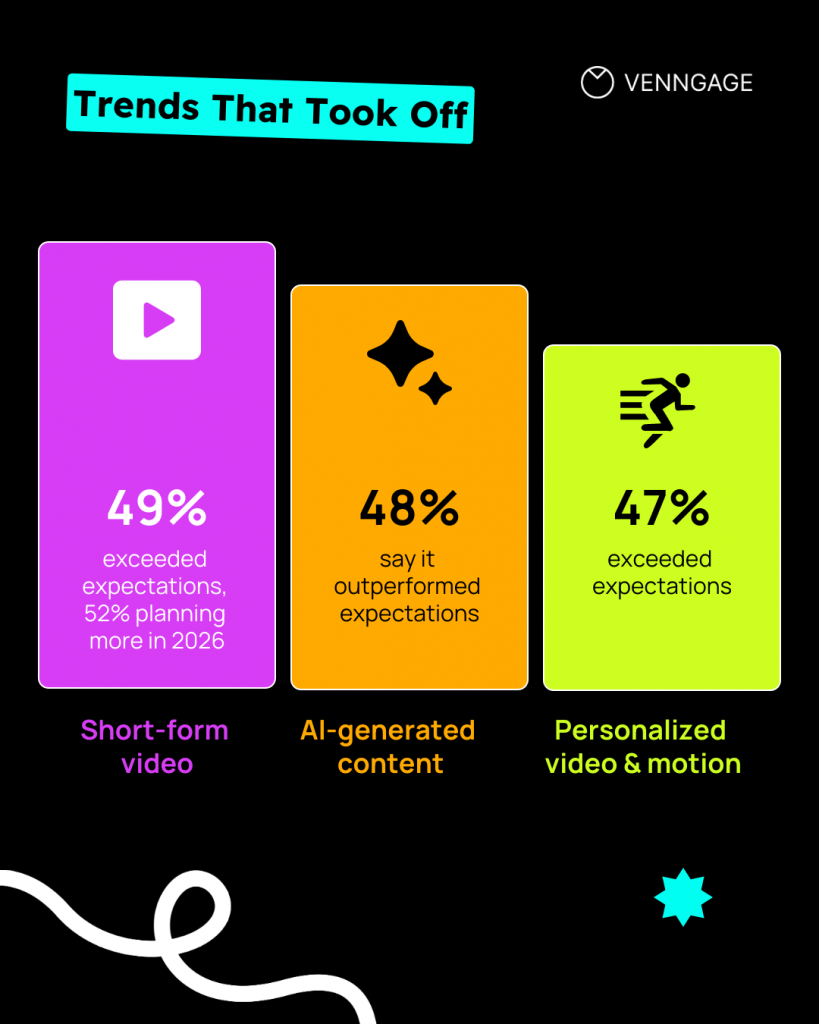
Expert insight
In 2025, the most game-changing shift for us was the move toward AI-driven personalization at scale — but not in the “throw their first name in an email” way. The real leap was AI’s ability to dynamically adjust onboarding flows, content, and even UI elements based on how a user actually behaved, not just what they told us in a form. For a platform like ours, that meant every client could deliver training that felt tailor-made without the manual work. It mattered because it directly improved engagement and retention — two metrics every SaaS lives and dies by.
Andrew Byzov, CMO at AcademyOcean AI-LMS
What this means:
- AI content creation is not a hype anymore. It outperforms older trends because it delivers real scale and efficiency benefits.
- Short-form video is an extremely reliable engagement driver. If you haven’t tried it yet, now is the time to invest in it.
- For now, AR and livestreaming remain niche trends or are still searching for scalable, repeatable use cases beyond pilot projects.
- The promise of visual SEO is growing steadily in importance, now that marketers plan to track visual search traffic metrics (39%) much more closely in 2026.
Expert insight
“2025’s real breakthrough wasn’t another filter — it was zero-party data storytelling. Brands that asked audiences directly created micro-narratives that boosted engagement, like email CTRs up 38%. Meanwhile, audiences rejected generic ‘AI art’ that lacked direction. Looking ahead, immersive shoppable video will become standard, and by 2026 we may see major campaigns tested entirely on synthetic audiences before going live. Success will come to teams that merge data, design, and empathy from day one.”
Jack Johnson, Operations Director, Rhino Rank
Expert insight
The biggest shift in 2025 was moving from optimizing for Google to optimizing for AI-driven answers — giving early adopters a clear edge in high-intent moments. Looking ahead, generative commerce will surface products directly inside conversational AI, redefining demand capture. Brands need to audit how they appear in AI answers now — this is the new front door to customer discovery. By 2026, AI recommendations may influence more consumer decisions than search results.
Samara Wiseman – Founder of Index Bureau
We asked: Tell us about a trend that really surprised you in a good way.
Here are a few highlights from what people shared:
Asking a question to followers on Instagram and having them answer while our brand was shown. Worked wonders for engagement. It boosted followers by 1500 in 3 days.
@Aurumbookseries
Dynamic email personalization has been very effective, which surprised me specifically because I assumed our open rates wouldn’t increase significantly, yet they have.
One trend that really surprised me in a good way is how AI is being used to make education more accessible and personalized. From language learning apps that adapt to your pace, to tools that help students with learning differences, it’s amazing to see how technology is creating more inclusive opportunities for people around the world to learn in ways that suit them best.
The trend that pleasantly surprised me is the rapid rise of “calm-tech”—interfaces that intentionally reduce screen time instead of demanding more of it. Seeing major apps roll out grayscale modes, notification batching, and even haptic-only alerts feels like the industry is finally prioritizing mental health over engagement metrics, and as a designer it’s refreshing to create experiences that help people unplug rather than hook them deeper.
Verdict:
Accurate for the most part: Short-form video exceeded expectations. AI content creation gained full steam. But AR and livestreaming remain niche trends, while visual SEO is yet to gain traction.
Section 4: Graphic design trends: What creators really used
In our 2024 graphic design trends forecast, we identified four major trends we believed would define the visual landscape in 2025:
What we predicted
- Personalized branding: We believed designs would adapt to audience segments with tailored colors, layouts, or data highlights to connect more deeply.
- Psychedelic nostalgia: We predicted a resurgence of retro visuals; bright neon colors, wavy typography, layered textures to evoke 60s and 70s vibes.
- Zero‑waste/Eco themes: We anticipated designers would lean into sustainable visuals such as modular layouts, minimal resource use, eco‑friendly fonts and color palettes.
- 3D and motion‑graphic visuals: We expected hyper-realistic 3D objects, kinetic motion graphics, and animated layouts to dominate visual storytelling.
What the data shows
The survey results reveal a more discerning approach to trend adoption. Designers embraced what offered genuine utility, while giving niche or resource-intensive trends a more measured chance.
- Dynamic or personalized visuals
- Adoption came in strong at 33%. Nearly half (46%) reported high engagement, and 37% said these visuals delivered strong campaign results. This supports the idea that adaptable templates and personalized design are becoming central to modern brand-building.
- Psychedelic/retro design
- Despite the early excitement, adoption was limited at 20%. Among those who tried it, 43% received constructive comments and admiration from audiences or teams. About 29% credited it with high interactions and strong performance, but overall, the trend stayed niche.
- Zero-waste or minimalist design
- This trend saw 24% adoption. Almost half (48%) of adopters reported positive feedback, showing growing appreciation for eco-friendly approaches. However, only 24% reported high engagement and 16% strong campaign performance, indicating that goodwill hasn’t yet translated into results.
- 3D and motion graphics
- This trend lived up to the buzz. 36% of respondents reported using 3D or motion-heavy visuals in 2025. Among adopters, 41% credited them with high engagement (comments, likes, shares), and 36% saw strong performance in reach, impressions, and click-through rates.
What this means
- 3D/Motion graphics and personalized branding resonate more strongly with audiences today, especially for brands focused on engagement and differentiation.
- The nostalgia related to retro/psychedelic designs appealed to a smaller niche, but it’s yet to take off as a “universal” best practice in 2025.
- Eco-conscious designs are growing in popularity, although audience engagement is currently a bit laggard right now.
Verdict
Mostly Accurate: Once again, our design trend predictions came true. Trends that offer practical utility such as 3D/motion graphics and personalization showed stronger adoption behavior. On the other hand, purely aesthetic trends like psychedelic, retro nostalgia and eco-friendly design showed promise without ROI (yet).
Missed signals: Trends that didn’t deliver
Here are a few trends that looked promising last year, but didn’t really translate into performance.
1. Retro/Psychedelic aesthetics: Nostalgia has its limits
The comeback of 60s/70s styles barely made an impression for most teams. These visuals created good buzz, no doubt, but failed to play a lasting role for the most part.
The lesson: Few trends work universally.“Throwback” only works for niche products or special events.
2. NFTs and Web3: The hype train just won’t move
Despite all the noise around Web3, NFTs and blockchain brands barely had any real results. Most teams simply didn’t use them. Of those who did, 41% called the results “neutral” at best.
The lesson: Not all headline-making trends translate into practical marketing wins.
Curious what’s next? Here are a few trends that our survey respondents said they are are betting on:
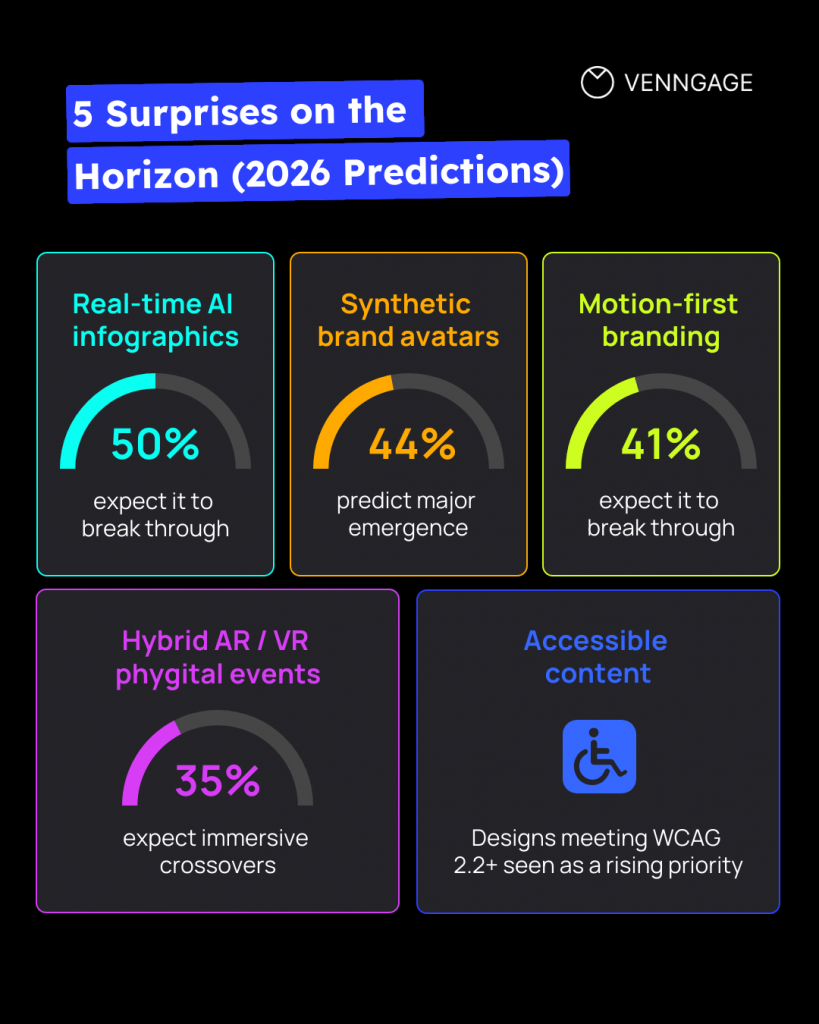
Mixed signals: Engagement is not everything
Let’s look at some of the trends that drove clicks and comments, but their impact is still hard to justify.
1. AR/VR and livestreaming: High effort, low reward
Despite above-average engagement rates (48%), AR/VR design formats couldn’t deliver good performance. For livestreaming, 38% people reported “mixed” results at best.
The takeaway: Immersive formats spark initial curiosity, but they still lack clear demand and ROI.
Zero-waste and eco-minimalism: Love without the likes
While 23% people said their brands leveraged zero-waste or minimalist design, only 16% reported strong campaign performance.
The takeaway: These trends carry plenty of goodwill, but are fueled more by leadership mandates and eco-conscious clients than by proven performance.
Patterns to watch
These two are areas that aren’t obvious today, but might evolve into a norm in the future.
1. Skill and resource bottlenecks
42% of respondents cited a lack of leadership buy-in as a top hurdle, with time, training and budget not far behind. This likely means that the “trend gap” will remain real in 2026 unless leaders prioritize skill-building.
2. More mature metrics
The growth of metrics like visual search clicks, brand sentiment, and carbon footprint marks a shift to more nuanced forms of “success” KPIs. Mature and timely metrics will shape both creative and strategic decisions going forward.
Where will brands put their money in 2026 and beyond? Our survey highlights the top budget priorities:
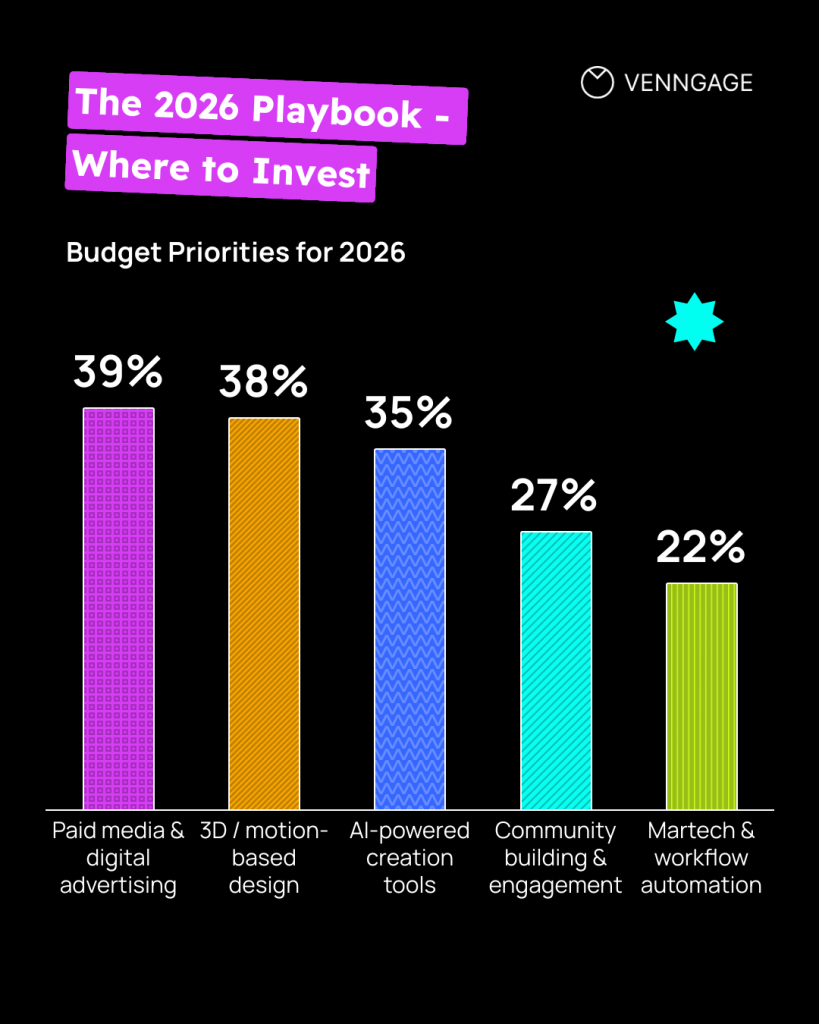
What marketers can learn from this
The reality check of design and marketing trends in 2025 offers practical lessons for marketers navigating a landscape where hype, utility, and authentic connection are in constant flux. Here are some actionable takeaways drawn from both predictions and what the data truly revealed.
1. Don’t chase trends for trends’ sake
The most successful teams don’t rush to apply every new format or tool right away. Survey data showed that micro-infographics, personalized visuals, and AI-driven content succeeded because they solved immediate, tangible problems such as improving audience reach, better engagement or speeding up execution.
2. AI can amplify good fundamentals, but not replace
While AI adoption is universal, it’s best for augmenting your existing workflows, speeding up execution, personalizing content and automating repetitive tasks. AI can’t fix a poor strategy, inconsistent messaging or mediocre design thinking. You still have to invest time to polish, edit and apply human judgment.
3. Reflection is as important as prediction
Review what actually moved the needle and iterate quickly when something doesn’t deliver. This means more intentional assessment, less time wasting on poor tactics and better flexibility to seize promising opportunities.
4. Go for engagement, not novelty
Formats like 3D/motion graphics and personalized branding stood out because they drive clear outcomes, not just because they looked “wow.” Ultimately, connecting with your specific audience should guide your business decisions.
All in all, strategic alignment reigns above everything else. Don’t chase all trends at once. Instead, choose the ones that can solve specific problems such as engagement, organic search or conversions.
Our survey also shows that the skills gap is changing fast. If you want to stay ahead of the curve, these are five areas to focus on now:
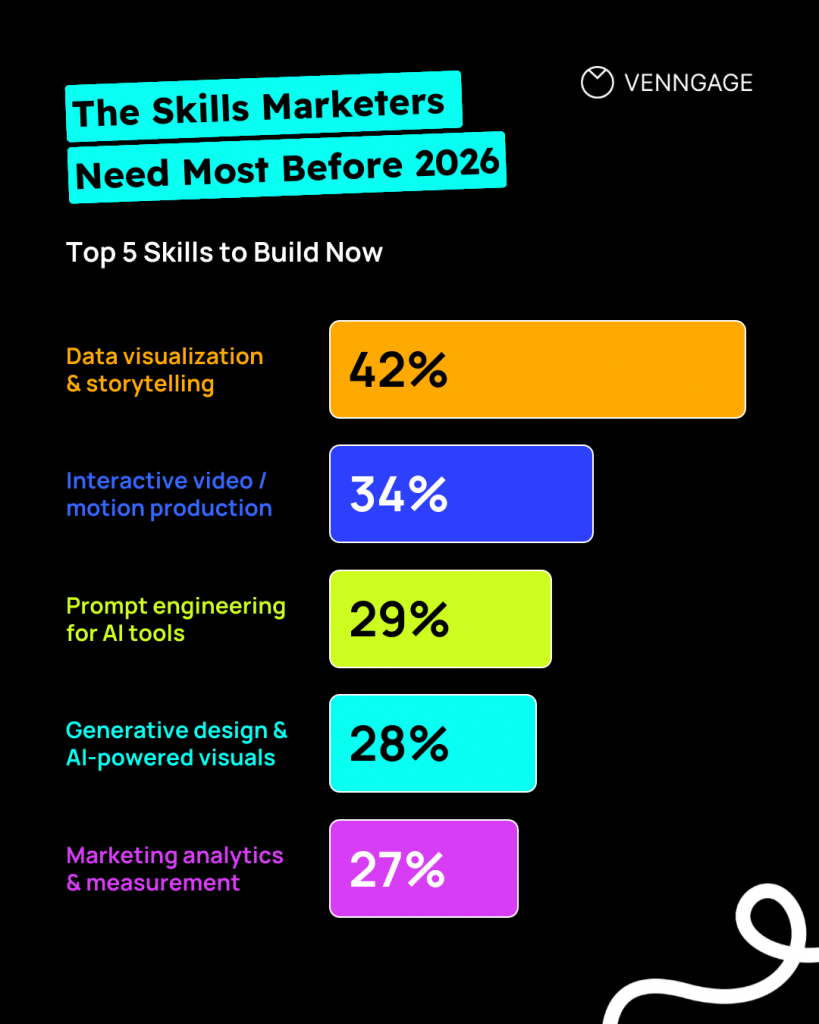
How to make the most of these trends
Savvy marketing teams treat trend adoption as an ongoing process, not a one-time bet. To make the most of what’s working (and sidestep what isn’t), run a thorough audit during or after you adopt a new trend.
Ask yourself and your team:
- Which experiments moved the needle on key metrics (engagement, conversion, reach) this year?
- Where did we see positive feedback or specific demand for more?
- Did certain tactics drain resources without proportional return, or require constant tweaking/editing to meet quality standards?
- How did audience needs shift, and which formats or tools helped us respond most effectively and authentically?
- Are we tracking new metrics (like visual search, interactive engagement, or personalization lift) that could put upcoming trends in clearer perspective?
Expert insight
If there’s one thing brands should start doing now, it’s building flexible design systems that can adapt quickly. Trends are moving faster than ever. A brand that can refresh its look, messaging, and assets without a full rebrand will stay ahead in 2026.
Shubham Sinha, Brand Identity & No-Code Web Designer
Audit regularly, such as quarterly or mid-campaign, and don’t be afraid to discontinue less effective tactics to free up your team’s bandwidth for what can gain you better traction.
Questions to ask before jumping on a new trend
Reflect before you invest. Use these prompts to guide tactical pivots and creative choices:
- Is the trend compatible with our brand’s goals, values and core audience?
- For example: An eCommerce apparel brand may adopt zero-waste visuals, but a fintech startup might skip them since clarity matters more for its audience.
- Will adopting this tactic help us stand out in our space, solve a specific challenge, or make our workflow more efficient?
- Are there clear success metrics and benchmarks to judge whether the trend delivers real value?
- Do we have the resources (skills, time, technology) to execute at a quality level, or will this cause strain elsewhere?
- A global hardware retailer can afford to produce slick 3D motion graphics, while a small local shop might struggle to justify the cost when simpler templates can get the job done.
- What would success look like, and how will we measure it before committing further?
The playbook is changing. These are the new performance indicators that will take center stage in the coming years:
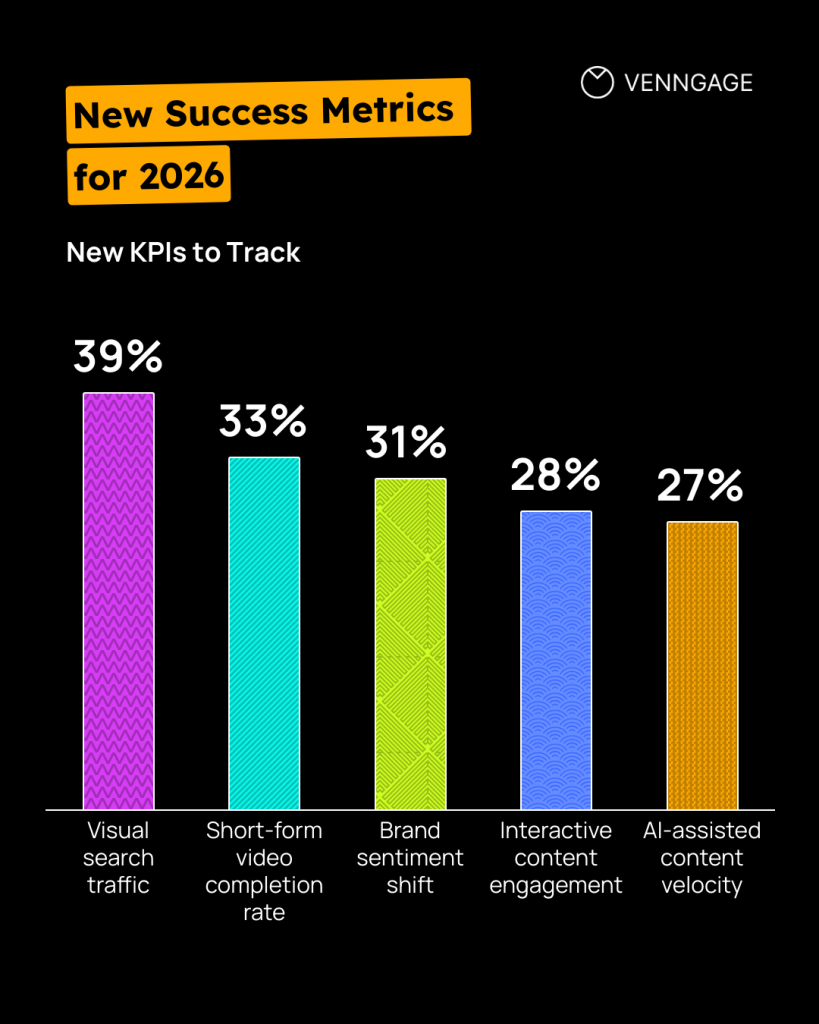
Venngage preview
At Venngage, the spirit of this audit-driven, audience-first approach is shaping the 2026 template and feature roadmap.
We are enhancing Venngage’s AI tools capabilities to support faster AI-powered design workflows, easy-to-use accessibility testing, and templates designed to maximize real engagement.
The goal is to allow marketers (read: non-designers) to execute faster and with data and insights to guide them through their campaigns.
Marketers who thrive in 2026 and beyond will be those who pick their trends mindfully, pair new tech with strong fundamentals, and treat every campaign as an opportunity to learn and refine.
Looking ahead into 2026
As 2025 is inching closer to an end, industry experts are setting their sights on 2026. They are anticipating a wave of AI and tech innovation that will push the boundaries of how we create, interact with and measure design and marketing content.
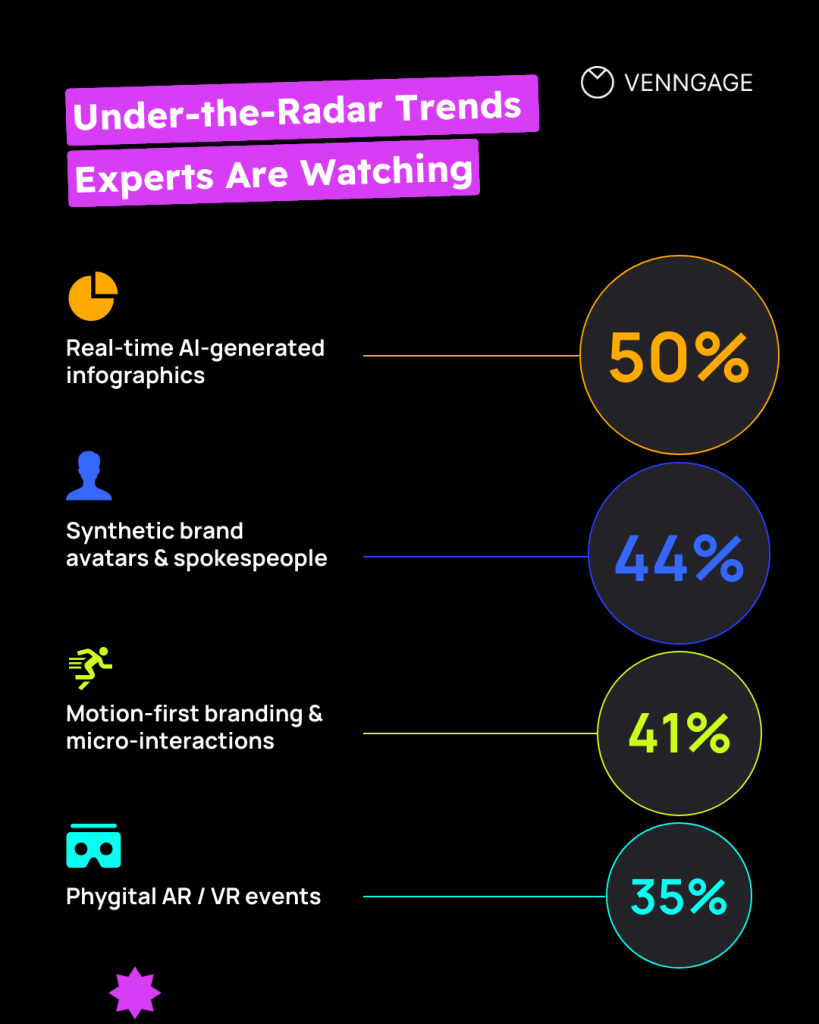
1. Deeper AR and 3D integration
The fusion of augmented reality and 3D design is expected to accelerate dramatically. We will likely witness print materials, such as infographics and brochures, “coming alive” through smartphone AR experiences.
Additionally, VR-enabled environments (like immersive data rooms) will transform storytelling into collaborative, richly interactive sessions. These technologies will bring data and narratives beyond static visuals, making engagement more tactile and memorable.
Expert insight
The future of digital marketing will not only consist of engaging in personally tailored content but rather consist of creating an entirely immersive experience that allows consumers to interact with brands in ways that are intimate and even collaborative.
Consider virtual spaces with the help of AI where the user is an active contributor to the creation or development of the material. When this is done correctly, marketers will not only change the way we engage with digital content, but also create a new benchmark that consumers will expect.
Mircea Dima, Co-Founder at AlgoCademy.com
2. Evolving data storytelling
The sophistication of data visualization will grow as designers focus on crafting personalized, interactive narratives. Users won’t just consume charts; they will drill down into live, customizable datasets that adapt to their interests or needs. This evolution will enable more meaningful connections between brands and audiences through transparency and contextual insights.
3. Mainstream eco-aware
Sustainability will move from a niche concern to a core design and marketing principle. Marketers and designers are expected to increasingly adopt zero-waste design practices, eco-friendly fonts, carbon-labeled assets, and modular, adaptable templates that reduce environmental impact. As consumers demand accountability, these choices will become both ethical imperatives and competitive advantages.
4. Tools and styles becoming more dynamic and accessible
The software and platforms powering marketing and design will evolve to support these trends seamlessly—offering faster AI-powered creation, enhanced accessibility compliance out of the box, and templates that balance aesthetic appeal with functional inclusivity. The aim is to make advanced, personalized, and responsible design the new standard rather than the exception.
5. Balancing innovation with authenticity
While the pace of change may be dizzying, leading brands will focus on clarity of purpose and human-centered creativity. As AI and automation level the technical playing field, trust, transparency, and genuine emotional resonance will differentiate successful campaigns.
This future promises to blend technology and humanity in ways that make marketing more immersive, effective, and responsible than ever before.
The teams mastering the human-AI interface today will dominate tomorrow. Don’t just follow trends: measure them, learn from them, and adapt faster than your competition.
What really matters: Measure, refine, and scale
Not every flashy prediction delivers, and the trends ruling 2025 prove that. More often than not, trends grounded in practicality, audience engagement and scalability win.
But the real winners aren’t the trends that rule. It’s the teams that hopped on these trends and continuously measured, refined and aligned them with their businesses goals.
In Part 2 of this blog, we will come up with a deeper outlook for 2026, where the challenge won’t be spotting trends, but mastering which ones truly matter. Stay tuned!




























